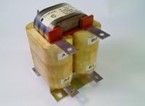
We collect basic website visitor information on this website and store it in cookies. We also utilize Google Analytics to track page view information to assist us in improving our website.

Harmonic Content - a crucial consideration for robust design of Inductors and Transformers, is often misunderstood and ignored by designers.
Switching devices used in power supplies, solar power invertors, battery charging circuits and other high-frequency power conversion equipment typically generate current at frequencies much higher than the fundamental operating frequency. Other common terms used to describe these higher frequencies are “upper harmonics”, “ripple current” (usually at the switching frequency) or “harmonic distortion”.
Buying that off-the-shelf 60Hz transformer or inductor may be a mistake because it may not have been designed with these harmonic currents in mind
Inefficiencies in the windings and core can greatly exceed those generated by the fundamental 60Hz operating frequency and can result in dangerous overheating. These inefficiencies come from “losses” in both the windings (turns) and the core.
Losses in the Windings include those due to I2R, skin and proximity effects; these vary exponentially with increasing frequency
I2R losses are generated by current flow through resistance in the winding conductor; these are a normal contributor to the losses in a standard transformer or inductor. Skin effect is the phenomena of uneven distribution of current flow at higher frequencies where current tends to travel in the outer layer of a conductor, effectively reducing the size of the conductor and increasing I2R losses.
Proximity effect is a similar redistribution of current at higher frequencies caused by the alternating magnetic field of the whole winding (layer effect). Therefore, as the harmonics increase, the size, shape and location of the conductor must be carefully optimized to maximize efficiency and minimize waste.
Similarly, losses in the Core material due to eddy and hysteresis effects also increase dramatically with the increasing frequency of these harmonic currents. Even smaller high-frequency magnetic fluxes can result in core losses often significantly higher than those for the fundamental operating current.
It is essential to choose appropriate materials and construction practices for windings and cores in order to avoid extreme overheating in switching magnetics.
This involves utilizing multi-stranded or Litz conductors or layers of varying thicknesses of copper foil to improve I2R losses in windings. For cores, use of thin layers of high-grade steel or amorphous metal or ferrites (random magnetic structure) can be used to mitigate the effects of eddy and hysteresis losses.
Remember: Proper design techniques carefully exercised by experienced designers will yield robust, efficient switching inductors and transformers that will perform reliability at lower temperatures and reduced weight.

